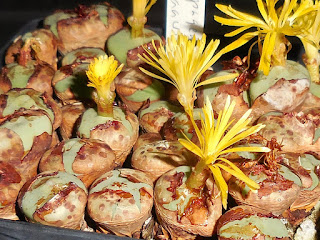 |
| Conophytum pageae from southwestern Bushmanland. Nocturnal summer flowers photographed with a flash. |
Plants in the genus Conophytum are all primarily cool-season growers, and most species flower at the start of major vegetative activity in autumn. A few conos bloom at the summer solstice, though: Conophytum frutescens, C. francoiseae, C. minusculum ssp. aestiflorens, C. bolusiae, and certain forms of C. pageae are all flowering for me right now.
Conophytum pageae has the widest geographic range of any Conophytum species, from the outskirts of the Knersvlakte in southern Namaqualand, all the way north into Namibia. There is a lot of variation in the plants over that range, and many species were separated out from C. pageae in the past. One of the more distinctive former species now considered C. pageae synonyms--Conophytum subrisum--is represented by the photo above. This particular batch of seedlings, from the southeastern part of the range of C. pageae, is a more or less classic "subrisum," with fairly large, greenish-yellow obconical leaves, with red lipstick-like markings late in the growing season, and flowers that are yellow, big and showy. Subrisum flowers also tend to happen very early, before the growing season otherwise starts and even in midsummer, as with these plants.
There is a definitely an argument to be made in favor of maintaining C. subrisum as a separate species; the trouble is all of the variation and combinations of traits seen in wild populations of C. pageae in the broad, modern sense of Steve Hammer's revisions of the genus. So, there are southern plants that are C. subrisum in every way, except that they flower at the end of autumn, five months later than the population pictured here. Or, there are are plants with good subrisum flowers and leaf coloration, but with small, round plant bodies the size of peas. There are populations with plants that are vegetatively subrisum, but with puny pale-tan flowers reminiscent of the former Conophytum minutiflorum, another C. pageaae synonym. I really don't know what the best taxonomic solution would be in this case; in the balance between trying to name all of the variation seen in nature, and acknowledging that the boundaries between different forms are murky and shifting, maybe the best solution is to sink everything into one wide-ranging and problematically variable species, Conophytum pageae.
No comments:
Post a Comment